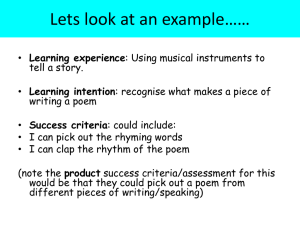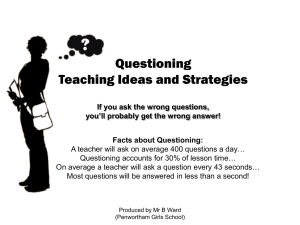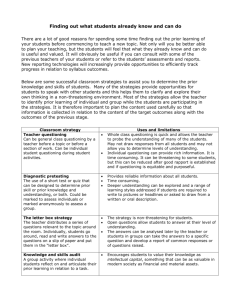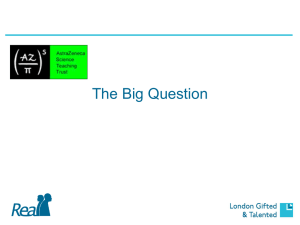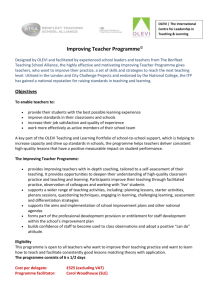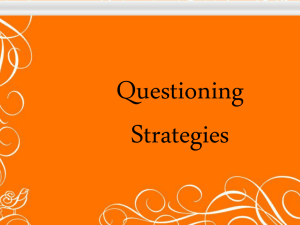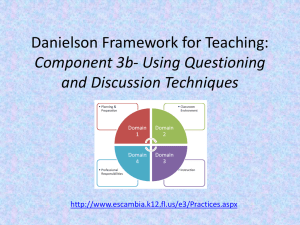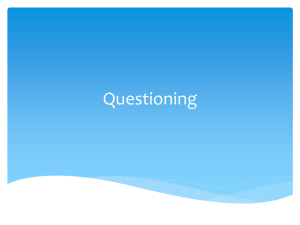Academic Questioning
advertisement
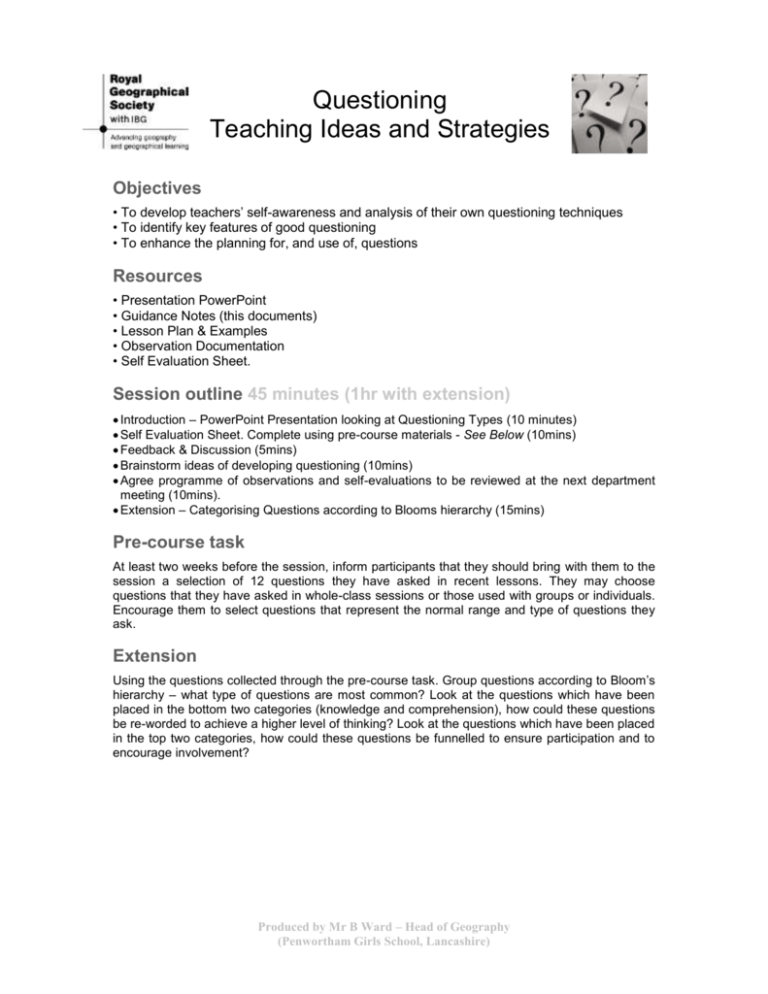
Questioning Teaching Ideas and Strategies Objectives • To develop teachers’ self-awareness and analysis of their own questioning techniques • To identify key features of good questioning • To enhance the planning for, and use of, questions Resources • Presentation PowerPoint • Guidance Notes (this documents) • Lesson Plan & Examples • Observation Documentation • Self Evaluation Sheet. Session outline 45 minutes (1hr with extension) Introduction – PowerPoint Presentation looking at Questioning Types (10 minutes) Self Evaluation Sheet. Complete using pre-course materials - See Below (10mins) Feedback & Discussion (5mins) Brainstorm ideas of developing questioning (10mins) Agree programme of observations and self-evaluations to be reviewed at the next department meeting (10mins). Extension – Categorising Questions according to Blooms hierarchy (15mins) Pre-course task At least two weeks before the session, inform participants that they should bring with them to the session a selection of 12 questions they have asked in recent lessons. They may choose questions that they have asked in whole-class sessions or those used with groups or individuals. Encourage them to select questions that represent the normal range and type of questions they ask. Extension Using the questions collected through the pre-course task. Group questions according to Bloom’s hierarchy – what type of questions are most common? Look at the questions which have been placed in the bottom two categories (knowledge and comprehension), how could these questions be re-worded to achieve a higher level of thinking? Look at the questions which have been placed in the top two categories, how could these questions be funnelled to ensure participation and to encourage involvement? Produced by Mr B Ward – Head of Geography (Penwortham Girls School, Lancashire) Guidance Notes Garbage in, garbage out, is a popular truth, often said in relation to computer systems: If you put the wrong information in, you'll get the wrong information out. The same principle applies to communications in general: If you ask the wrong questions, you’ll probably get the wrong answer, or at least not quite what you’re hoping for. Asking the right question is at the heart of effective communications and information exchange. By using the right questions in a particular situation, you can improve a whole range of communications skills: for example, you can gather better information and learn more; you can build stronger relationships, manage people more effectively and help others to learn too. Effective questioning techniques are a part of the art of teaching. Appropriately-formed questions can help students dig within themselves for more thought and reflection. Students can make discoveries and be challenged to think more critically. Facts about Questioning: A teacher will ask on average 400 questions a day… Questioning accounts for 30% of lesson time… On average a teacher will ask a question every 43 seconds… Most questions will be answered in less than a second! The Importance of Questioning Questioning is a critical skill for teachers because it is: the most common form of interaction between teacher and pupil; an element of virtually every type and model of lesson; a key method of providing appropriate challenge for all pupils; an important influence on the extent of progress made; the most immediate and accessible way for a teacher to assess learning. Purposes of Questioning to interest, engage and challenge pupils; to check on prior knowledge; to stimulate recall and use of existing knowledge and experience in order to create new understanding and meaning; to focus thinking on key concepts and issues; to extend pupils’ thinking from the concrete and factual to the analytical and evaluative; to promote reasoning, problem solving, evaluation and the formulation of hypotheses; to promote pupils’ thinking about the way they have learned. Produced by Mr B Ward – Head of Geography (Penwortham Girls School, Lancashire) Approaches to Questioning Closed questions Definition A common definition of a closed question is: a question that can be answered with either a single word or a short phrase. Examples include 'what was your homework?' and 'What is the capital of England?' Using closed questions Closed questions have the following characteristics: They give you facts. They are easy to answer (and therefore can be used for building confidence) They are quick to answer (and thus can create a ‘snappy’ start to a conversion) They keep control of the conversation with the questioner. As closed questions are easiest to control, teachers will often feel more confident using this style of questioning. Unfortunately, must closed questions require simple responses and therefore rarely challenge the responding student. Closed questions are usually knowledge or comprehension based and are thus found at the bottom of blooms pyramid (See appendix). When teaching groups which include ‘able’ students closed questions should only be used a means to initiate dialogue, once students are involved in the debate open questions (see next section) should predominate, closed questions at this stage could stifle the conversation and prevent student progression/learning. However, when teaching low ability pupils, or students who lack confidence in your subject, closed questioning is most likely to maximise pupil response/involvement. One of the biggest problems associated with closed questions is that the teacher is often expecting a specific answer, resulting in the ‘guest what I’m thinking’ situation. Often, meaningful responses will be provided, and discarded, as they were not the response the teacher was looking for, confusing and de-motivating the students involved. Produced by Mr B Ward – Head of Geography (Penwortham Girls School, Lancashire) Open questions Definition An open question can be defined as: A question which is likely to receive a long answer. Although technically any question could receive a long response, open questions deliberately seek longer answers. Using open questions Open questions have the following characteristics: They ask the respondent to think and reflect. They will give you opinions and feelings. They hand control of the conversation to the respondent. This makes open questions useful in lessons as a follow-on from closed questions when you wish to develop the conversation. Using open questions can be scary, as they hand the direction of the conversation over to the other person. However, well-placed questions do leave you in control as you steer pupil interest and direct the conversation where you want them. Open questions will usually require the respondent to think about their reply, and will normally create challenge. An open style of questioning will encourage students to reflect, evaluate and conclude, the highest levels on Blooms pyramid (see appendix). When planning conversations, a good balance is around two or three closed questions to one open question. The closed questions start the conversation and summarize progress, whilst the open question gets the other person thinking and developing their understanding. Questioning can be used as an effective tool for differentiating a lesson – closed questions can be aimed at pupils who find your subject difficult (building confidence), whilst open questioning can be targeted at stretching the most able. This form of differentiation has the additional benefit that participating pupils are unlikely to be aware that ability streaming has occurred. For successful open questioning, the teacher must learn to wait. Pupils will need time to think about a challenging question. Do not be afraid to wait; waiting is a sign that you want thoughtful participation. Waiting time can be structured by repeating the questioning, and holding back before directing the question at an specific individual. Try to avoid the natural temptation to answer the question yourself if pupil responses are not immediately. (See funnelling – a technique which can be used to draw out responses to challenging questions). Produced by Mr B Ward – Head of Geography (Penwortham Girls School, Lancashire) Whenever in doubt as to what to ask, just dip into these questions. Why are you saying that? What exactly does this mean? How does this relate to what we have been talking about? How did you choose those assumptions? Please explain why/how ... ? What would happen if ... ? Why is that happening? How do you know this? What do you think causes ... ? How might it be refuted? What alternative ways of looking at this are there? Why it is ... necessary? Who benefits from this? What is the difference between... and...? Why is it better than ...? What are the strengths and weaknesses of...? How are ... and ... similar? Why is ... important? What is the best ... ? Why? How did this happen? Who would be affected? When would you have experienced...? Where is this likely? Why? Funnel Questions This technique uses closed questions and can be used to draw detailed information from a respondent, a series of questions are asked each focusing on a point given in the previous answer. In class, funnelling could be used to test the understanding of a quiet pupil or develop the confidence of a student who felt they were unable to answer an open question. In many ways, funnelling can be viewed as creating a writing frame for oral exchanges. e.g. Open question – Explain the process which results in the formation of a river cliff on the outside of meander? This can be replaced with a funnelling of closed questions… Q1. Where on a meander is the water deepest? Q2. Where the water is deep, will the current be fast or slow? Q3. What process is created by fast flowing water? Q4. Does erosion lead to the build-up or the breakdown of material? Funnelling can be extremely effective when trying to gather information from students who are reluctant participates in the questioning process. Produced by Mr B Ward – Head of Geography (Penwortham Girls School, Lancashire) Probing Questions Like funnelling, probing is a technique which can be used to dig deeper. Probing questions are best used as a follow-up to open responses, and should be used to ensure dialogue stays on focus. Due to the nature of open questioning respondents may have ‘wavered’ from the topic the questioner intended to get information on, in these circumstances probing questions can be used to refocus the dialogue and ensure understanding. Probing can be as simple as asking your respondent for an example, or requesting additional information to clarify a point which has been raised. e.g. you mentioned that many migrants want to move to countries like Britain. Could you explain why? e.g. you said pull factors explain this movement from the countryside to the city. Could you give me three examples of what you mean by pull factors? Leading Questions Leading questions tend to be closed in nature and have the effect of leading the respondent to your way of thinking. Leading questions are good for getting the answer you want, whilst leaving the other person feeling that they have had a choice. Leading questions can be achieved by using a number of grammar techniques: a) By adding a personal appeal to agree at the end of the question: e.g. “You will hand-in your coursework on time, won’t you?” b) Phrasing the question so that the “easiest” response is “yes” (our natural tendency to prefer to say “yes” than “no” plays an important part in this approach to questioning): e.g. “so your homework will be on my desk first thing Monday morning?” c) Giving a student a choice between two options, both of which you would be happy with. Strictly speaking, the choice of “neither” is still available when you ask “Which would you prefer of A or B”, but most people will be caught up in deciding between your two preferences. e.g. When will you do your detention at lunchtime or after school? – As such a question eliminates the debate whether the detention should be completed at all a positive response is more likely to be achieved, and as the student made the choice (and therefore agreed to the detention) attendance is also more likely. Another example could be “You have the choice of apologising to Mrs ??? for your behaviour or completing a lunch time detention, what will it be? This question automatically assumes the child behaviour was unacceptable, removing this aspect of debate from the conversation. Produced by Mr B Ward – Head of Geography (Penwortham Girls School, Lancashire) In Summary… Effective Questioning: involves arrange of styles, including both closed and open questions; reinforces and revisits the learning objectives; includes ‘staging’ questions to increase the level of challenge in a lesson; involves all pupils; engages pupils in thinking for themselves; promotes justification and reasoning; pupil ability/confidence is recognised by the questioner resulting in an appropriate style of questioning; creates an atmosphere of trust where pupils’ opinions and ideas are valued; shows connections between previous and new learning; encourages pupils to speculate and hypothesise; encourages pupils to ask as well as to ‘receive’ questions; encourages pupils to listen and respond to each other as well as to the teacher. Questioning Pitfalls It is easy to fall into the trap of: asking too many closed questions; asking pupils questions to which they can respond with a simple yes or no answer; asking too many short-answer, recall-based questions; asking bogus ‘guess what I’m thinking’ questions; dealing ineffectively with incorrect answers or misconceptions; focusing on a small number of pupils and not involving the whole class; making the sequence of questions too rigid; not giving pupils time to reflect, or to pose their own questions. Produced by Mr B Ward – Head of Geography (Penwortham Girls School, Lancashire) Appendix Bloom’s taxonomy of questioning The Taxonomy of Educational Objectives was originally created in the 1950's by Bloom as a means of categorising levels of thinking. Bloom's Taxonomy has since been adapted in classrooms all over the world for use as a planning and evaluation tool and continues to be the most universally applied model for questioning differentiation. 1 Knowledge 2 Comprehension 3 Application 4 Analysis 5 Synthesis 6 Evaluation During the 1990s Lorin Anderson (a former student of Bloom) led a team to revise the taxonomy with the view to examining its relevance for the twenty-first century. One of the main differences they proposed was in the nomenclature, and particularly in the change of nouns to verbs (e.g. from 'knowledge' to 'remembering') in order to stress the active nature of thinking. In addition to this, Anderson replaced 'evaluation' with 'creativity' as what he perceived to be the highest-order thinking skill. Anderson’s taxonomy of questioning 1 Remembering (recall) 2 Understanding (explain) 3 Applying (use) 4 Analysing (differentiate) 5 Evaluating (justify) 6 Creating (generate) Produced by Mr B Ward – Head of Geography (Penwortham Girls School, Lancashire)
